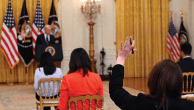The questions that naturally follow are about the future: Do these changes in the news agenda represent some long-term transformation?
When the war subsides and the threat against America from terrorism is perceived to be less imminent, will the nightly news and the morning news return to a pre-September 11th definition of normalcy?
In short, does the data suggest that journalism has been transformed in some deep-seated way?
The answer, at this point, can be only speculative. But there are important pieces of evidence to consider.
One is that the news agenda has changed historically with changes in the socio-economic and political landscape. The 1920s, like the 1990s, were a time of push toward celebrity, gossip and softening of news. The term tabloid came into use. Press critics wrung their hands over the rise of rumor as news and the popularity of figures like columnist and radio host Walter Winchell. The era was defined by an economic boom, a turn inward after World War I, and the advent of new technology—radio.
In the 1930s, the news agenda was transformed by The Great Depression. People’s concerns became more serious, and so did journalism.
This suggests that the degree to which today’s changes in the news agenda stay with us will depend less on the journalists than on the extent to which the country has been transformed.
A second factor concerns the audience. The changed news agenda may be more long-term if it is attracting new viewers to the news. Here, so far, the evidence is positive, if premature.
All three evening newscasts have more viewers than a year ago in contrast to years of general decline. In the period between September 24 and November 11, ABC was up 15% over the year before, CBS up 9% and NBC 7%, according to data from Nielsen Media Research.
The morning shows are also up, though also modestly. The biggest winner appears to be the most serious of the three. ABC’s Good Morning America is up 8% in total viewers in the latest four-week period over the same period a year ago, when the Florida election recount story dominated the news. In total numbers it still trails the Today Show but is closing the gap.2
Some cautions: The gains are smaller among younger viewers, and they have slipped somewhat in recent weeks.
There are some positive signs. The Pew Research Center for the People and the Press, for instance, has found high approval ratings for the press’ coverage of the terrorism crisis so far, but those numbers have shrunk somewhat over time. In the first 8 days after September 11, 89% of the public gave the press high marks for its coverage3, but that number slipped to 85% by October 44 and to 74% by October 15.5
A third factor is economic. The war on terrorism has cost the networks, and all news gathering operations, significantly. Round-the-clock, ad-free coverage of the September 11 attacks and their aftermath cost the networks alone an estimated $320 million in lost revenue.6 The total estimated cost rises to between $950 million and $1.1 billion when all broadcast, cable, and local television are considered.7
How will the networks choose to recoup that money? By trying to build and keep the potential new audience with more serious news? By trying to lure in more advertisers with product tie-ins and sponsored segments? By packing more ads into each broadcast? Or by cutting costs even further at their overtaxed news operations?
A fourth factor is the public. To a degree, journalists have indicated privately, their parent companies dare not complain about the high cost of coverage because doing so would appear unpatriotic. How long will this last? If the terrorism crisis is perceived to be a lingering one, it may be considered untenable to cut back too much, and even Wall Street may allow the networks to earn less profit from their news operations.
One thing in the data, however, suggests the change may be temporary. Much of the move toward hard news is focused around one subject, the war on terrorism, rather than some broader based shift toward hard news on a range of topics. In that sense, this is the same single focus we have seen from the press on such previous stories as O.J. Simpson, the Clinton-Lewinsky scandal, Gary Condit, and Princess Diana. If so, this may suggest the media culture has simply shifted its gaze momentarily to this story, rather than recalibrated more fundamentally how it approaches the news.
2 Nielsen Media Research morning news program ratings data, prepared by CBS Research
3 “American psyche reeling from terror attacks,” Pew Research Center for the People and the Press, September 19, 2001
4 “September 11 shock slow to recede – 42% still depressed,” Pew Research Center for the People and the Press, October 4, 2001
5 “Public remains steady in face of anthrax scare,” Pew Research Center for the People and the Press, October 15, 2001
6 Seth Sutel, “Media companies’ financial woes compounded by fallout from terrorist attacks,” Associated Press, September 19, 2001
7 Greg Johnson, “Coverage cost nears $1 billion,” Los Angeles Times, September 20, 2001




